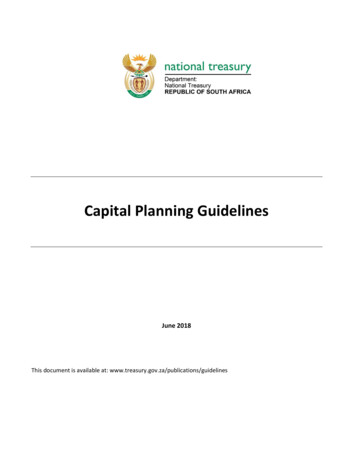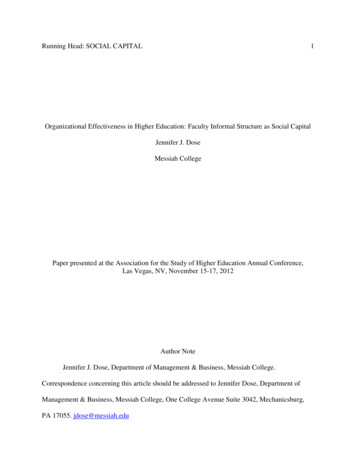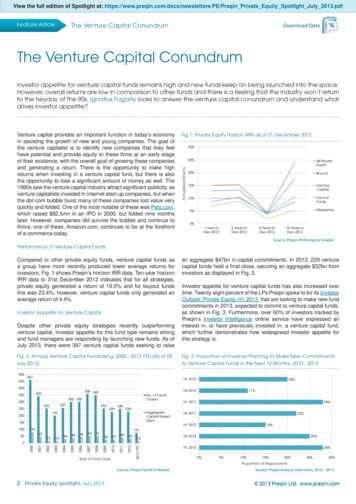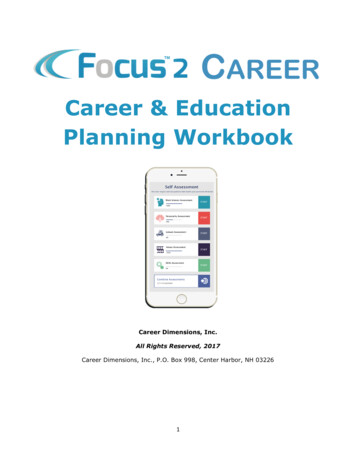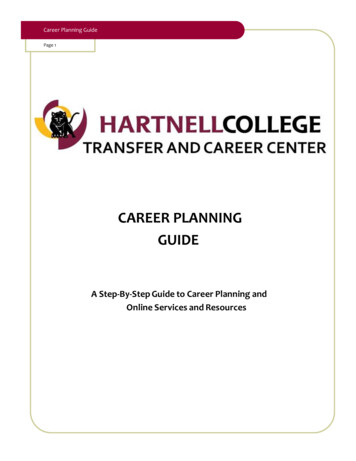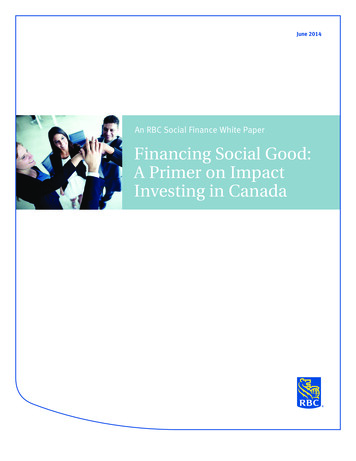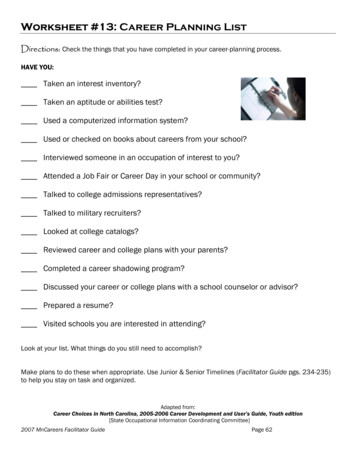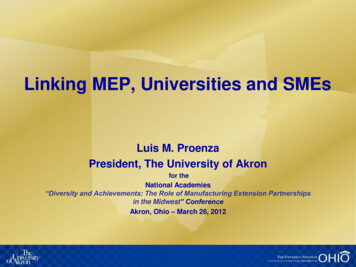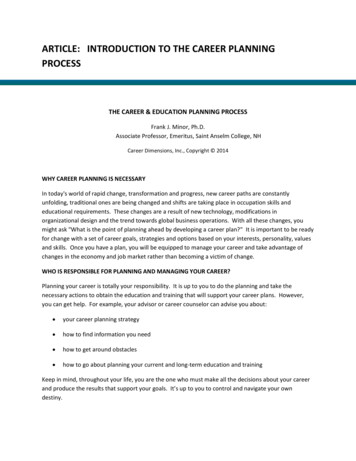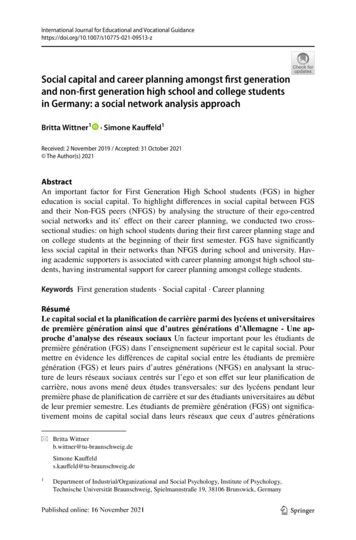
Transcription
International Journal for Educational and Vocational Social capital and career planning amongst first generationand non‑first generation high school and college studentsin Germany: a social network analysis approachBritta Wittner1· Simone Kauffeld1Received: 2 November 2019 / Accepted: 31 October 2021 The Author(s) 2021AbstractAn important factor for First Generation High School students (FGS) in highereducation is social capital. To highlight differences in social capital between FGSand their Non-FGS peers (NFGS) by analysing the structure of their ego-centredsocial networks and its’ effect on their career planning, we conducted two crosssectional studies: on high school students during their first career planning stage andon college students at the beginning of their first semester. FGS have significantlyless social capital in their networks than NFGS during school and university. Having academic supporters is associated with career planning amongst high school students, having instrumental support for career planning amongst college students.Keywords First generation students · Social capital · Career planningRésuméLe capital social et la planification de carrière parmi des lycéens et universitairesde première génération ainsi que d’autres générations d’Allemagne - Une approche d’analyse des réseaux sociaux Un facteur important pour les étudiants depremière génération (FGS) dans l’enseignement supérieur est le capital social. Pourmettre en évidence les différences de capital social entre les étudiants de premièregénération (FGS) et leurs pairs d’autres générations (NFGS) en analysant la structure de leurs réseaux sociaux centrés sur l’ego et son effet sur leur planification decarrière, nous avons mené deux études transversales: sur des lycéens pendant leurpremière phase de planification de carrière et sur des étudiants universitaires au débutde leur premier semestre. Les étudiants de première génération (FGS) ont significativement moins de capital social dans leurs réseaux que ceux d’autres générations* Britta Wittnerb.wittner@tu-braunschweig.deSimone Kauffelds.kauffeld@tu-braunschweig.de1Department of Industrial/Organizational and Social Psychology, Institute of Psychology,Technische Universität Braunschweig, Spielmannstraße 19, 38106 Brunswick, Germany13Vol.:(0123456789)
International Journal for Educational and Vocational Guidance(NFGS) pendant la scolarité et l’université. Le fait d’avoir des soutiens académiquesest associé à la planification de carrière chez les lycéens et le fait d’avoir un soutieninstrumental à la planification de carrière chez les étudiants.ZusammenfassungSoziales Kapital und Karriereplanung–Soziale Netzwerkanalyse der egozentrierten Netzwerke von deutschen First-Generation Studierenden vor und nachdem Übergang an die Hochschule Soziales Kapital ist ein wichtiger Erfolgsfaktorfür First-Generation Studierende (FGS) an Hochschulen. Um die Unterschiede imsozialen Kapital zwischen FGS und nicht-FGS (NFGS) zu beleuchten, werden dieStrukturen ihrer egozentrierten Sozialen Netzwerke sowie der Zusammenhang zuihrer Karriereplanung analysiert. Die Ergebnisse zweier Querschnittsstudien (jemit Oberstufenschülerinnen und Erstsemesterstudierenden) zeigen, dass FGS übersignifikant geringeres soziales Kapital in ihren Netzwerken verfügen und dieses nutzen können. In der Schule sind unterstützenden Akademiker*innen wichtig für dieKarriereplanung, während zu Beginn des Studiums instrumentelle Unterstützung benötigt wird.ResumenCapital social y planificación de la carrera entre estudiantes de educación secundaria y estudiantes universitarios de primera generación y de no primerageneración en Alemania - un enfoque desde el análisis de redes sociales Un factor importante para los estudiantes de primera generación (PGS) en la educaciónsuperior es el capital social. Con el fin de resaltar las diferencias en el capital socialentre PGS y sus pares no PGS (NPGS) mediante el análisis de la estructura de susredes sociales centradas en el yo y sus efectos en la planificación de su carrera, realizamos dos estudios transversales: en estudiantes de educación secundaria durante suprimera etapa de planificación de carrera y en estudiantes universitarios al comienzode su primer semestre. Los estudiantes PGS tienen significativamente menos capitalsocial en sus redes que NPGS durante el instituto y la universidad. Tener partidariosacadémicos está asociado con la planificación de la carrera entre los estudiantes deeducación secundaria, y también con tener un apoyo fundamental para la planificación de la carrera entre los estudiantes universitarios.IntroductionIn modern society, achieving a higher education than your parents seems to be amore desirable goal than ever. For many students, being the first in the family tostart a tertiary education is not an easy path. While only 37% of First GenerationHigh School students (FGHS) in Germany who hold a degree that enables them tostart at universities (German secondary school leaving examination Abitur) decideto take up courses (Middendorf et al., 2012), 80% of students with an academic family background (Not First Generation Students, NFGS)—students whose mothers,fathers or both hold university degrees—get a college education. In an attempt at13
International Journal for Educational and Vocational Guidancesocial advancement, FGS tend to choose more practical majors (business studies,teaching degrees) than their peers, which promise more financial security (Kojakuet al., 1998). Although FGS account for 50% of the total student population in Germany, they are a group at high risk of dropping out of their studies early. One infive leaves, the university or at least their field of study (Ishitani, 2006; Middendorf et al., 2012). This might be because an individual’s education and status is stilldependent on their intergenerational background and this does not only include theparental generation but might go back as far as one’s great grandparents (Braun &Stuhler, 2018). An explanation could be that individuals often inherit their families’social class and therefore start with different amounts of social capital, meaning thepeople you get to know and the support you thereby receive (Bourdieu, 1987).Pascarella et al. (2004) group FGS research into three general topics: (1) comparison studies of FGS versus academic offspring, (2) the transition phase from schoolsto college or university and (3) the university experience of FGS, e.g. college lifeand retention (Pascarella et al., 2004). In all three research topics, FGS seem to havemore difficulties than their peers. To analyse what kind of social capital is important for FGS and NFGS, we conducted two studies incorporating all three topics.Considering that students will likely lose memberships to some former communities and will build new relationships to adapt to university during their transition(Tinto, 1975, 1987; Elkins et al., 2000) we opted for two studies: one before and oneafter transition to university. In study one, we focus on first generation and non-firstgeneration high school students (FGHS and NFGHS) in a pre-transition stage closeto their matriculation examination (German Abitur). Study two analyses college students in an early post-transition stage shortly after deciding on a tertiary education.In both studies, we also provide evidence on how different social capital is linked tocareer planning for both FGS and NFGS.Whilst individuals face ongoing career decisions over their lifetime, the firstcareer decision is tough and seems to be life-defining for high school students.Career planning, as the ability to deliberate future careers and goals and planningsteps to reach them (Gould, 1979), is influential in these decisions. Being able tochoose between 327 non-academic vocational educations (Bundesinstitut fürBerufsbildung, 2018) and over 8000 bachelor degree programmes in Germany alone(Hochschulrektorenkonferenz, 2016), most high school students seek support forcareer planning which is often found in the individual’s closest social circle. Therefore, we chose a social network analyses (SNA) procedure to see where college andhigh school students gain their social capital from. Precisely, we analyse the supporters in participants networks, which we explain in detail later on. Most studiesanalyse the support students retrieve from their parents or the social support thestudents feel they get (e.g., Levine & Nidiffer, 1996). By having FGS include theirwhole support system and not only their parents or teachers, we gain insights intothe support they have access to and how effectively they use the network. In a fairlynew approach, we combine this SNA data with the psychometric dependent variablecareer planning ability.With this study, we contribute to a deeper understanding of social capital manifestation in FGS social networks as an antecedent for career planning and add tothe research on FGS in all three key topics (Thomas & Quinn, 2007), answering13
International Journal for Educational and Vocational Guidancethe questions of whether they have less social capital in their social networks andwhether this social capital is important for their career planning. This helps to establish suitable steps for helping FGS on their academic and occupational path. We doso by giving a theoretical introduction to social capital as well as career planningand highlight the role of FGS status in both concepts. The results are discussed withregards to improving the situation for FGS.Social capital as the key to successSocial capital is a widely used construct in social sciences as well as psychology butlacks a clear unifying definition. Attempts vary from a structural definition (Burt,2000) to one based on actors “bonding and bridging” (Putnam, 2000; for an overview see Claridge, 2004). In general, social capital refers to the social and relationship resources an individual and all actors can access to achieve certain goals theywould not have reached alone (Coleman, 1988). According to Bourdieu (1986),social capital means the totality of real or potential resources from membership ina group. Its power is measured in the “material or symbolic profits” gained from therelationships and the form of capital associated with membership (i.e. economic,cultural, or symbolic capital) in a certain class (Bourdieu, 1987). The access to these“more or less institutionalized relationships of mutual acquaintance and recognition” (Bourdieu & Wacquant, 1992, p. 119) is restricted by various constraints, suchas race, gender and class. According to this definition, FGS are likely to have lesssocial capital with regards to university than their fellow students, since they wereneither born into an academic network nor belong to the group themselves yet.Approaches to social capital analysis differ in accordance with its definition,from single-item measures (mostly in sociology) to psychometrical scales (Schulz &Schwarzer, 2003) to social network analysis. We chose the last approach and providean overview in the next paragraphs.Social capital in social networksSocial capital in social network analyses refers to contacts (called alters in socialnetwork analysis) that help an individual (called ego in social network analysis) touse their human capital (knowledge, competencies) (Burt, 1992). Being in such anetwork enables all actors to gain benefits by their social structures (Portes, 1993).Social capital has been defined widely during the last few decades. Early operationalisations mainly focused on the sheer size of the network and the power ofthe people in it (Bourdieu, 1986) or on social network structure. According to Burt(1992), social capital materializes in networks in four ways: size of network, heterogeneity, compositional quality and density. Network size means the sum of peoplean ego names as the ones supporting him or her. The size can also vary due to theform of support: social emotional (e.g. companionship), instrumental (supportiveactions), informational (giving information), appraisal (e.g. feedback; House, 1981).With regards to the research questions, all support forms—emotional support, instrumental support for academic achievements and instrumental career support—can be13
International Journal for Educational and Vocational Guidancecounted in one general support network or they could be analysed individually. Heterogenity is a way of explaining how people in the network differ from each otherand ego on certain aspects (e.g. gender, age ). High heterogeneity is supposedlybeneficial for social capital as a diverse network offers a broader range of ideas andresources; that is, if it does not conflict with compositional quality. Compositionalquality means the sum of alters with high levels of necessary resources such asknowledge and power. While these structures are beneficial to social capital, densityis controversial. Density is the proportion of alters that have a relationship with eachother or at least know each other. In favour of cohesion, it is an indicator of closerelationships and beneficial (Crossley, 2005). On the other hand, it could possiblyharm an individual’s social capital. In a highly dense network, all alters know eachother and the same things, which could lead to group think and uniform influences(Granovetter, 1973).FGS are faced with a lack of economic as well as social capital (Soares, 2007).They gain less information from their parents directly, even though parents try tobe supportive and are often more proud than other parents. In addition, they oftenreport feeling less supported by tutors and teachers compared to NFGS, althoughthey might be in their network (Stanton-Salazar, 2001). Once at university, FGS seldomly feel they can approach staff and faculty with their problems (Jenkins et al.,2013; Pike & Kuh, 2005). Social capital from other contexts might be limited bysocial class, since individuals tend to form relationships with people similar to them(homophily; Granovetter, 1983).Social capital theory: combining accessibility and mobilisation of contactsAcknowledging that social capital is more than relationships and networks (Lin,1999), Lin (2001) combines a variety of SNA approaches in his social capital theory(Figure 1).According to the theory, social inequality depicts the access to network resources(accessibility) and contact resources (mobilization). Whereas network resources areall possible resources in the ego-centred network, contact resources refer to usedresources that lie in the contacts’ characteristics (knowledge, power). Naturally,accessibility influences mobilisation, whilst both lead to instrumental returns (e.g.university success) and expressive returns (e.g. satisfaction). FGS face inequalitiesduring their school and university experience (Rubio et al., 2008) and they havepotentially less access to a network helpful for facing career decisions and cannotmobilise it as well as NFGS (Engle & Tinto, 2008). FGS are often assumed to havelower social capital (Moschetti & Hudley, 2015). Being the first in their family tostudy, they have a hard time accessing a helpful network. Most adolescents’ networks are influenced by their parents (Mounts, 2000). Due to the same environment,they share many contacts by chance as well as by introducing them to influentialpeople. Furthermore, relationships often develop due to homophily (shared interests or characteristics). This influences students’ and parents’ networks alike. Sincesocial capital can be contextual, we concentrate on support networks with regardsto school, university and career related factors. FGS are often raised in low-income13
International Journal for Educational and Vocational Guidanceareas with citizens having low social capital (American Psychological Association,2013) and often shy away from asking teachers for help (Terenzini et al., 1996).Less educated environments could lead to smaller support networks in educationalmatters, whilst getting to know fewer academics. The purpose of our studies is toanalyse the social networks of FGS for the social capital they hold and its effect onstudents’ career planning. We assume that FGS have significantly (a) smaller networks and (b) fewer academic alters than NFGS (H1).Understandably, one can only mobilise contacts they have in a network. While allforms of support are important for successful careers (Dobrow & Higgins, 2005),mobilising supporters for a specific task can be more difficult. Concerning careerplanning, instrumental support matching the task is more important than social emotional support (Zikic & Klehe, 2006). In order to represent the contextual importance of instrumental support, we analysed supporters that were specifically usedfor support for career decision-making. We expect to find that compared to NFGS,FGS have significantly (a) fewer alters to provide them with instrumental supportfor vocational decision-making and (b) fewer academic alters providing them withinstrumental support for vocational decision-making (H2).First vocational choice and career planning: what capital do you need?High school and college students face a variety of simultaneous developmentalprocesses to becoming adults (Jordan & Kauffeld, 2018). Nonetheless, the importance of career planning increases in late adolescents (Super, 1990), as it is the basisfor the complete path of ones’ career and shown to be related to career satisfaction (Aryee & Debrah, 1993) and career success (Hall, 2002). Career planning isan ongoing process through all stages in life (Zikic & Klehe, 2006) and since thefinal direction is not clear yet, career planning is still very important during the firstyears at university (Jordan & Kauffeld, 2018). This is especially true in the Germantertiary education system. Students must decide on a major before enrolling at a university and not only apply to a university but also for their field of study (bachelor’sprogramme). They cannot start university without a declared major, and changingmajors is not as easy as in other higher education systems (e.g. the USA). For example, high school students could choose to apply to major in engineering. Starting atuniversity, they lay a wider basis for the coming career but need to narrow it downfurther to a specific field in engineering or a certain industry.The first vocational choice is often based on own motives, values and interests(Super, 1990). However, career planning not only depends on the individual’s abilities (human capital) but also on the opportunities and information social capitalprovides (Friesen, 2011). In the context of careers research in adulthood, so-calleddevelopmental networks are key. In these networks, all actors support an individualin their career-oriented development by providing mostly professional support (Higgins & Kram, 2001). Mentoring, a dyadic approach to building support networks,shows to improve students’ career planning (Renn et al., 2014). Using the developmental network approach on students’ career planning takes into account howcareer goal setting as well as planning is often influenced by social context (Lent13
International Journal for Educational and Vocational Guidanceet al., 2000) and that students have more than one support person to help them withtheir career. Especially for Goulds approach of career planning a developmental network is helpful. Supporters may help with the deliberation of future careers and giveimportant insights. They can help formulate realistic goals and (as experienced inthe professional world) can help planning the steps to reach these career goals. Interms of career decisions, both close and loose contacts can be beneficial. Strongrelationships, such as family, can provide help in difficult transitions, whilst weakrelationships have a high probability of offering fast new information (Barthauer &Kauffeld, 2018). According to Granovetter (1979) having a widespread network provides the individual with diverse information on jobs and job opportunities. Nevertheless, adolescents tend to search for support and often use more available contactsinstead of supporters they assess as most helpful (Taviera et al., 1998).According to social capital theory (Lin, 2001), accessibility and mobilisation isan important success factor for both advantaged (NFGS) and disadvantaged (FGS)groups. While the first career decisions are difficult, career planning does not stopafter choosing an academic field.Therefore, we assume in both studies that career planning can be significantlypredicted by accessibility of social capital [(a) network size, (b) number of academicalters] and mobilisation of social capital [(c) degree of instrumental support, (d)degree of instrumental support by academic alters] (H3).To represent individuals during their first career decision in school as well as thefirst steps at university, we conducted two cross-sectional studies from a high schoolstudents’ panel and a university freshmen panel.Study 1: Social capital and high school students’ career planningMethodParticipantsThe study sample consists of 90 high school students in senior classes (68% year 11,27.5% year 12 and 2.2% in year 13, which is the last year in certain school forms)from the same city. We chose schools from the same city to control for regionaleffects of the educational federalism in the German school system (in Germanyeducation is decided in each federal government, respectively). Participants wereon average 16.9 years old (SD .81). Girls made up 65.9% whilst 33% were boys.On average, 90 participants named 5.97 alters (SD 3.47) in their ego-networks.On average, 1.97 (SD 2.23) alters per network offered vocational support. Seventeen percent of all alters had a tertiary degree and were therefore presumed tobe academics. One third of the high school students in the sample self-identified asFGS (n 30). As there are various definitions of the term FGS, Toutkoushian et al.(2018) request researchers to describe their measure in detail. While all measures ofFGS have the same tendency in their results, we decided on a perceptual approach,to include a variety of concepts on nuclear family and university experiences. Therefore, in this study, being the first in the family to study was measured as their social13
International Journal for Educational and Vocational Guidanceidentity (Tajfel et al., 1979) by a single item to measure their perceived status assuch (“Are you the first in your family to study at a University?” or “Would you bethe first in your family to study at a University?” for the high school sample). Withan average score of career planning of M 3.37 (SD 1.19) for FGS and M 3.42(SD 1.07) for NFGS career planning levels were low in both groups.InstrumentsCareer planning Career planning was measured by a German translation of Gould’s(1979) career planning scale (Rowold, 2004). Commonly used in various studies(Thomas et al., 2007), the scale is related to salary, adaptability (Gould, 1979) andfollowing a carer strategically (Aryee & Debrah, 1993).The scale consists of 9 items on a 6-point scale from 1 (not at all) to 6 (completely) with two subscales (career adaptability and career planning). Sample itemsare: “I have a plan for my career” and “I know what I have to do to fulfil my careergoals”. Cronbach’s alpha coefficients in this study were good, with α .86 for thefirst study and α .80 for the second study.Developmental network questionnaire Participants were asked to list up to 20 alters(e.g. friends from school, parents, teachers) that support them in their career development in a so called name generator. As name generator, we asked participantsfor people who supported them with regards to school, university and career relatedfactors during the last six months and provided example behaviours of possible supporters (e.g. providing information or creating career opportunities) to facilitate thename gathering for the participants (adaptation from Dobrow & Higgins, 2005). Thenumber if alters they decided to list is the network size.Next, participants were presented with a set of questions for each alter theymentioned as a member of their social network (e.g. relationship—are they family,friends, friends from university; age; academic degree reaching from no degree tohabilitation treatise) and were able to decide which support form alters were offering them: socio-emotional support and instrumental support for vocational decisionmaking and university. To help participants rank the support forms, we gave definitions at the beginning of the questionnaire. Participants were able to check as manyforms of support they gained from an alter as they felt applied.We counted alters as academic if they had atleast a bachelor’s degree and usedthe support form as reported by the participants.ProcedureIn the two studies we used paper pencil surveys with psychometrical scales (careerplanning ability) as well as social network questionnaires. Samples in study one andstudy two consist of both FGS and NFG students. The unit of analysis is the egoand the network of each participant. The description of the alters provides furtherinsights into the composition of the participants’ networks.13
International Journal for Educational and Vocational GuidanceIn study one, we chose to focus on high school students’ social capital since weassume it to be influential on their first career planning steps and in leading them ontowards successful (academic) careers. The data were gathered in high schools offering their students a programme in which they can choose to participate in a careercoaching. All of the participants applied for a career decision-making programmein schools in lower Saxony. Some of them got the treatment right after the surveywhilst others had to wait six months for the coaching. All of them got our surveybefore the programme started.Data preparation: social support measures in networksWe measured social capital according to Burt (1992, 2000) whilst applying Lin’sModel of social capital. We used network size (also referred to as degree) and compositional quality (Burt, 1992) as measures for students’ social capital accessibility(Lin, 2001).Degree /network size is the sum of all alters in an ego network. Since all contactswere valuable for ego, we did not filter for specific support.Support is often referred to a specific context. Compositional quality argues thatsocial capital is also measured by the support an ego gains for a specific cause.According to Burt (2000), we measured the alters’ possessing of characteristics valuable to ego. In this case, we used their academic background.Furthermore, we measured mobilised social capital (Lin, 2001) by alters usedfor instrumental support for career decision-making as well as by combining theacademic background of alters with this specific instrumental support. We assumedacademic help to be mobilised if alters with academic background gave instrumentalsupport instead of general support.ControlsWe controlled for age and gender. While both are an influencing factor for networkparameters (Barthauer et al., 2016; Vaux, 1985), age can also affect career maturity(Creed et al., 2007). As explained above, participants applied for a career decisionmaking programme. Though all participants had not received any information at orbefore measurement and attended the same schools and classes, participating in theprogramme was used as a control variable, since Jordan et al. (2017) found an effectin a similar programme.Data analysesTo test our hypotheses, we used SPSS 25. To reduce possible multicollinearity,predictors were mean centred before conducting the regression analyses (Aiken &West, 1991). We first ran the tests on our hypotheses 2 and 3 for the whole sample inboth studies. To establish whether against our assumption that they might only applyto FGS, we calculated the same regression analyses for FGS only.13
International Journal for Educational and Vocational GuidanceTable 1 Means and Standard Deviation of all relevant variables for both FGS and NFGS in study 1FGSMNFGSSDMtpCohen’s dSDNetwork size5.454.236.213.02 .87.14Sum acad. Alters.761.091.241.44 1.78.04.38Instrumental Support.31.54.981.40 .573 .001.63Acad. Instrumental support.48.82.931.28 1.78.04.42Table 2 Study 1 Bivariate Correlations amongst assessed constructsVariableMSD1 Treatment2 Age23.26** .0316.89 .813 Gender.1645678 .27** .10 .16.12.35** .27** .11 .30** .23* .05 .20* .19* .014 Sum Alters5.975.97.41*** .78***5 Sum Academic Alters1.071.35.43***6 Instrumental support1.962.237 Academic Instrumental Support.671.188 Career Planning3.62.84 .12.13.40*** .05.88*** .23*.50*** .26*.11N 90; M and SD are given*p .05, **p .01, ***p .001Results study 1For hypothesis one, we conducted four one-tailed independent sample t-tests tocompare (1) network size, (2) sum of academic alters and (3) instrumental support and (4) instrumental support by academic alters in FGS and NFGS conditions. We used one-sided tests since we assume a directional effect. There was nosignificant difference in network size for FGS (M 5.45, SD 4.23) and NFGS(M 6.21, SD 3.02); t (42) .87, p .14. There was a significant difference inacademic alters for FGS (M .76, SD 1.09), who reported significantly less academics than NFGS (M 1.24, SD 1.44); t (71) 1.78, p .04, d .38. Again,there was also a significant difference in instrumental support for FGS (M .31,SD .54) and NFGS (M . 98, SD 1.40); t (81) .573, p .001, d .63, andthey significantly differed in instrumental support by academics t(71) 1.78,p .04, d .42 (MFGS .48, SDFGS .82; MNFGS .93, SDNFGS 1.28) (Tables 1,2).All variables’ correlations can be found in table two. In contrast to our hypothesisH3, only sum of academic alters and inst
sectional studies: on high school students during their rst career planning stage and on college students at the beginning of their rst semester. FGS have signicantly less social capital in their networks than NFGS during school and university. Hav-ing academic supporters is associated with career planning amongst high school stu-

